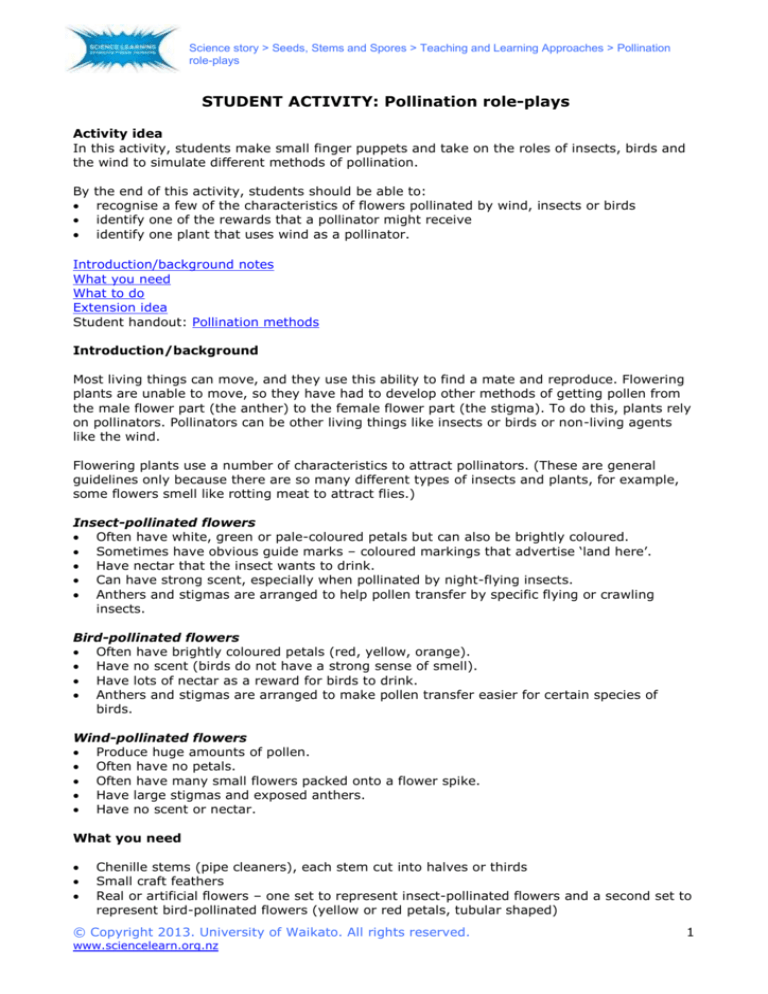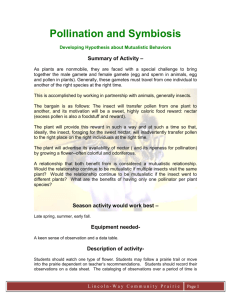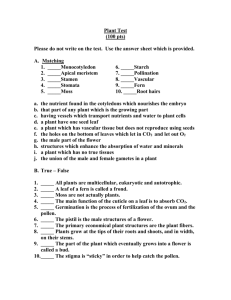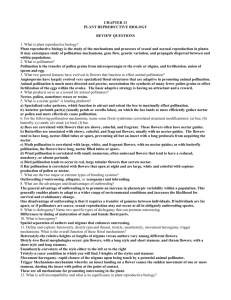
Science story > Seeds, Stems and Spores > Teaching and Learning Approaches > Pollination
role-plays
STUDENT ACTIVITY: Pollination role-plays
Activity idea
In this activity, students make small finger puppets and take on the roles of insects, birds and
the wind to simulate different methods of pollination.
By
the end of this activity, students should be able to:
recognise a few of the characteristics of flowers pollinated by wind, insects or birds
identify one of the rewards that a pollinator might receive
identify one plant that uses wind as a pollinator.
Introduction/background notes
What you need
What to do
Extension idea
Student handout: Pollination methods
Introduction/background
Most living things can move, and they use this ability to find a mate and reproduce. Flowering
plants are unable to move, so they have had to develop other methods of getting pollen from
the male flower part (the anther) to the female flower part (the stigma). To do this, plants rely
on pollinators. Pollinators can be other living things like insects or birds or non-living agents
like the wind.
Flowering plants use a number of characteristics to attract pollinators. (These are general
guidelines only because there are so many different types of insects and plants, for example,
some flowers smell like rotting meat to attract flies.)
Insect-pollinated flowers
Often have white, green or pale-coloured petals but can also be brightly coloured.
Sometimes have obvious guide marks – coloured markings that advertise ‘land here’.
Have nectar that the insect wants to drink.
Can have strong scent, especially when pollinated by night-flying insects.
Anthers and stigmas are arranged to help pollen transfer by specific flying or crawling
insects.
Bird-pollinated flowers
Often have brightly coloured petals (red, yellow, orange).
Have no scent (birds do not have a strong sense of smell).
Have lots of nectar as a reward for birds to drink.
Anthers and stigmas are arranged to make pollen transfer easier for certain species of
birds.
Wind-pollinated flowers
Produce huge amounts of pollen.
Often have no petals.
Often have many small flowers packed onto a flower spike.
Have large stigmas and exposed anthers.
Have no scent or nectar.
What you need
Chenille stems (pipe cleaners), each stem cut into halves or thirds
Small craft feathers
Real or artificial flowers – one set to represent insect-pollinated flowers and a second set to
represent bird-pollinated flowers (yellow or red petals, tubular shaped)
© Copyright 2013. University of Waikato. All rights reserved.
www.sciencelearn.org.nz
1
Science story > Seeds, Stems and Spores > Teaching and Learning Approaches > Pollination
role-plays
Grass stems with seedheads
Perfume (spray this onto the insect-pollinated flowers prior to class if using artificial
flowers)
Baby powder or cornflour (liberally dust the insides of the artificial flowers and grass stems
with this prior to class)
Small pieces of chopped fruit (grapes, sultanas and so on)
Copies of the student handout Pollination methods
What to do
1. Before working with the students, read the article Attracting pollinators and preview the
video Bird pollination in New Zealand. This is for your own background knowledge but could
be shown to your students if you think the video is appropriate for them.
2. With the students, introduce the concept of reproduction. Male and female cats come
together to produce kittens but plants do something different. Why? Because plants cannot
move so they have to find a way to get pollen from the male part (anther) to the female
part (stigma).
3. Ask students if they know how this happens. (Insects, birds, wind.)
4. If appropriate, watch the video Bird pollination in New Zealand. With younger students,
consider watching sections of the video, without sound, and explain what is happening on
the screen. The section from 0:38–0:54 shows insect pollination. Bird pollination is shown
from 1:20–1:50 and again from 2:10–2:30. Stop the video and discuss flower shape,
colour, beak size and shape and whether the plant is strong enough to hold an insect or a
bird.
5. View the images Honey bee on flower (insect pollinated), Tūī on flax flowers (bird
pollinated) and Maize (sweet corn) flowers (wind pollinated). Discuss the characteristics
each plant has to make use of its pollinator. (The petals act as a landing stage to show
insects where to land. The flowers produce lots of nectar and have a scent. The flax flowers
are shaped to accommodate a bird’s beak, produce lots of nectar and are yellow. The flax
stems are strong enough to hold the weight of a feeding bird. The maize plant produces
lots of pollen on anthers that are exposed to the wind. It does not have a colourful, scented
flower nor does it produce nectar because it does not have to attract pollinators.)
6. Use the chenille stems (pipe cleaners) to create bees. Students twist yellow and black
stems together to form a single stem. They then twist this around an index finger, leaving
the ends to form the bee’s wings. Their fingertip becomes the bee’s body.
7. Use a coloured chenille pipe cleaner and two feathers to create birds. Students lay the
feathers on the pipe cleaner and twist it around the quills to secure the feathers. They then
twist it around their other index finger. Their fingertip becomes the bird’s beak.
8. Appoint one student to represent the insect-pollinated flowers and another to represent the
bird-pollinated flowers. They hold the flowers in one hand and a container with small pieces
2
© Copyright 2013. University of Waikato. All rights reserved.
www.sciencelearn.org.nz
Science story > Seeds, Stems and Spores > Teaching and Learning Approaches > Pollination
role-plays
of fruit in the other. The fruit represents nectar – the reward the flower gives to pollinators
in return for visiting the flower and brushing against the pollen. (Discuss the difference
between nectar and fruit. We are using fruit because it is sweet, like nectar, and easier for
us to use than real nectar would be.)
9. Appoint another student to represent the wind-pollinated grass. They hold the grass stems.
10. Turn your class into a garden by releasing the bees and birds to fly around:
When they approach the bee-pollinated flower, they poke their bee finger into one of
the flowers. They get to take away their nectar reward (fruit).
When they approach the bird-pollinated flower, they poke their bird’s beak into one of
the flowers. Again, they are rewarded with nectar (fruit).
When they approach the wind-pollinated grass flower, they hold their birds or bees
behind their backs and blow on the grass, simulating the wind.
11. Once the nectar has run out, ask the students to sit on the mat with their birds and bees.
Look to see if there is evidence of pollen (powder or cornflour) on their pollinator. Look at
the student holding the wind-pollinated grass. Is there evidence that the pollen has
travelled via the wind?
12. Use the student handout Pollination methods to record the students’ ideas and/or
experiences of pollination. The handout is in Word format. You are able to change the
instructions or add/remove words from the word bank to suit your students’ needs.
Extension idea
The student activity Pollination pairs has flower cards and pollinator cards that you can print to
make a memory game. Look at each flower card and discuss how the flower is pollinated. With
young students, you may wish to put small insect or bird stickers on the pollinator cards to
help the students with reading/vocabulary.
© Copyright 2013. University of Waikato. All rights reserved.
www.sciencelearn.org.nz
3
Science story > Seeds, Stems and Spores > Teaching and Learning Approaches > Pollination role-plays
Student handout: Pollination methods
Write about how these different types of flower pass their pollen from one flower to another.
Insect pollination
Bird pollination
Wind pollination
nectar
anther
scent
birds
pollen
branches
insect
bee
© Copyright 2013. University of Waikato. All rights reserved.
www.sciencelearn.org.nz
Word bank
petals
tui
stigma
grass
colours
flower
reward
4









